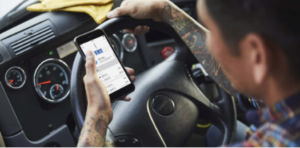In the nearly two decades we’ve been in business, DriverSource has seen many positive changes in the trucking industry. Technological innovations have made trucking cheaper, more productive and faster. Improvements in multimodal transportation, using a combination of air, rail, and road transport, have also had a positive effect on trucking practices. But, none of these advances can match the fundamental changes we are currently experiencing as a result of the digitization of the industry.
Digital Freight Brokering – An Uber-Like Business Model
Mobile connectivity, primarily through the ELDs and smartphones, to digital freight brokerage platforms are enabling brokers to analyze capacity (both HOS and trailer volume) to provide load-matching and real-time pricing to owner-operators and carriers seeking to maximize their assets. This business model is referred to by some in the industry as “Uber for trucks” and is expected to grow rapidly to nearly $60 billion by 2025. It is reshaping the logistics business model and will require newer types of commercial vehicles.
https://www.freightwaves.com/news/thought-leadership/trucking-industrys-transformation-future
Urban Pick-up and Delivery Demand Will Surge
The global urban middle class is growing. Consumers are increasingly expecting their online purchases to be delivered quickly (often by the next day). Additionally, as online sales increase, there is also an uptake in returns, meaning that the last-mile networks of tomorrow will need to be optimized for both delivery and pick-up while handling a greater volume of goods.
It’s all resulting in an increasing demand for city trucks used for urban pick-up and delivery. These trucks will fulfill the need for predictable shipping and guaranteed deliveries promised by companies such as Amazon. In the past, the process of getting a package from factory to distributor to the customer was complicated. It often involved up to a dozen companies and a lot of paperwork. Cloud-based freight management systems such as Carrier Logistics Inc.’s FACTS allows shippers to schedule deliveries and to calculate ETAs. Driving times to each stop is calculated, with handling times determined by type of delivery – business, residential, inside deliveries, curbside and more. The digital platform allows for these business-to-customer deliveries to be rerouted and redirected on a short notice from the customer.
https://carrierlogistics.com/carrier-software-features/
For last-mile deliveries, industry experts are predicting that electric trucks may eventually make the most sense in crowded urban areas. These vehicles will avoid the pollution concerns associated with diesel trucks. Cities have also made it easier to set up charging stations where they’re needed, so a carrier could employ a large fleet of smaller electric trucks, thereby drastically reducing the price of fuel per delivery.
In summary, as last-mile delivery demands continue to grow, trucking companies will move towards an Uber-like operation to meet the requirements of freight delivery in densely populated areas. It will be an operation representing a combination of fuel-efficient, smaller trucks with mobile connectivity to digital freight brokerage platforms to provide the just-in-time efficiencies demanded by consumers.
Bill D for DriverSource


